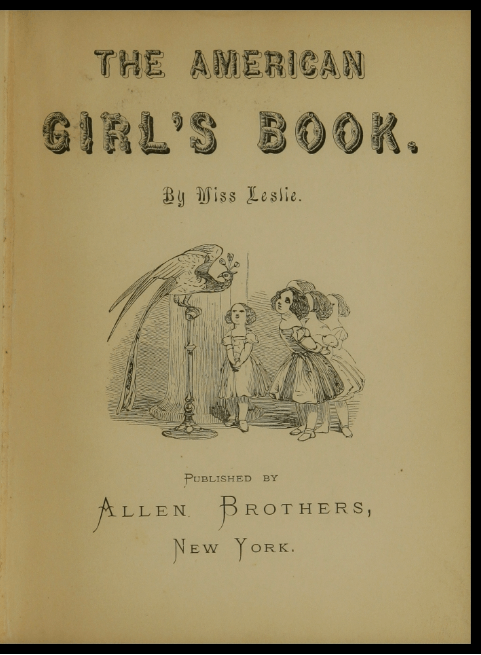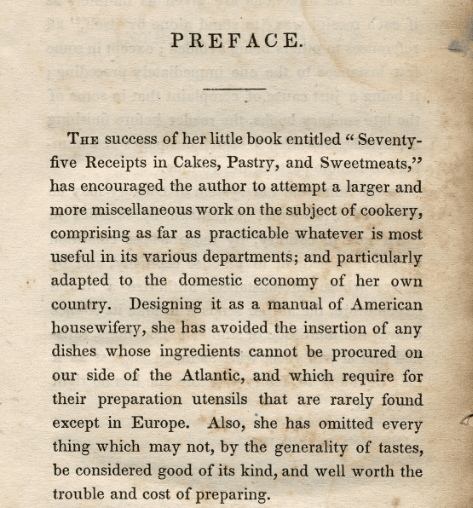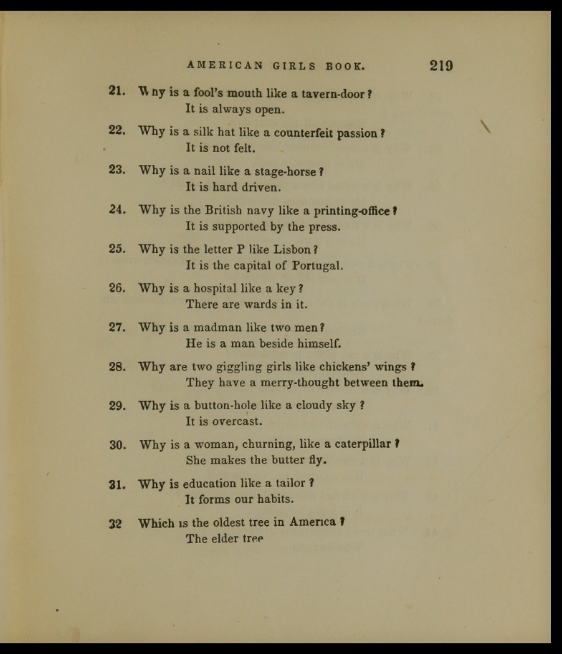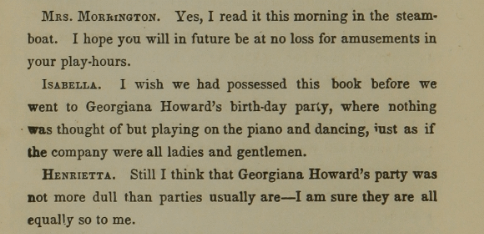Eliza Leslie: A publishing powerhouse
This month we’ve been celebrating the release of two resources: Children’s Literature and Culture, and the second module of Food & Drink in History.
I was lucky enough to work on commissioning documents for both titles, and one of the best parts of my job is making connections between our resources – connections across history. Many parts of my job are extremely rewarding, but one of the best is making connections between our resources – connections across history.
I made one such connection at the American Antiquarian Society when I opened a children’s book titled The American Girls’ Book; Or, Occupation for Play Hours and emitted a yelp of excitement. The author was Eliza Leslie, a name I knew very well from Food & Drink in History; it was like stumbling into an old friend.

The American Girl's Book; Or, Occupation For Play ..., 1869, Content compilation (c) 2020, by the American Antiquarian Society. All rights reserved.
Eliza Leslie’s cookbooks are legendary; users will find several of her successful and influential titles in the resource, such as Seventy-Five Receipts for Pastry, Cakes and Sweet Meats, a book credited with the first printed mention of the phrase ‘cupcake’, and Miss Leslie’s lady’s new receipt book, containing the first printed recipe for chocolate cake printed in the USA, introducing Americans to a European favourite.
The resource also contains several editions of Directions for Cookery, in its various branches – most notably, a first edition sourced from Michigan State University. Getting hold of a first edition of this cookbook is no mean feat; Directions for Cookery was the bestselling American cookbook of the 19th century, shifting over 150,000 copies and going through over fifty reprintings.
You can compare how the book changed over time using the Comparing Multi-Edition Cookbooks tool in the resource. It’s important to state that in most cases, Leslie’s recipes aren’t unique – she borrows heavily from other published works, from European cuisines, and appropriates from American Indian foodways with minimal acknowledgement of her inspiration, or stereotypical depictions of those communities.
The key to Leslie’s success was the simplicity of her presentation and the relevance of her recipes. Her mission statement is clear in her preface; the recipes were adapted to the domestic economy of America, avoided ingredients that couldn’t be found “on our side of the Atlantic”, recipes are to be useful to families in urban or rural locations, and the instructions are explicitly designed to assist “even inexperienced cooks”.

Directions for cookery, in its various branches, 1..., 1837, © Content compilation © 2019, by the Michigan State University. All rights reserved.
Recipes are clearly laid out with simple, concise instructions, sprinkled with her top tips and advice about fresh ingredients and pantry staples. Leslie’s recipes incorporated local ingredients, like corn and catfish, and she often suggests alternative ingredients, creating flexible recipes easily adaptable to what you have to hand.
She wanted to write cookbooks for American housewives, subverting the complexity of highbrow European texts by providing more details on basic things like cooking equipment. So many cookbooks assume so much knowledge about cooking and food of the reader, but what happens if as a young, new housewife, and you don’t have that knowledge?
Leslie’s cookbooks and later her domestic management and etiquette books bridge that gap, establishing her brand as a household go-to .Leslie was also famously funny; in her later years she was said to hold court in her Philadelphia hotel home, shocking strangers with her sarcastic turn of phrase and acerbic observations. In her cookbooks, she infuses her prose with a directness that is often entertaining – Eliza Leslie brooks no nonsense, and does not accept second best:

Directions for cookery, in its various branches, 1..., 1837, © Content compilation © 2019, by the Michigan State University. All rights reserved.
It seems natural that a writer with a talent to write with such clarity and wit should also produce children’s books designed to entertain and educate.
Whilst not as commercially successful as her cookbooks, Leslie was able to leverage her authority as a household manager and flex her creative muscles to create a volume choc full of suggestions for fun pastimes for middle-class girls, including sports, card games, needlework, plays and music, decorated with simple illustrations and beautiful engravings.
There is even a section on jokes – though I’d wager few would even make it into a Christmas cracker these days!

The American Girl's Book; Or, Occupation For Play ..., 1869, Content compilation (c) 2020, by the American Antiquarian Society. All rights reserved.
Leslie incorporates more story telling elements into her children’s book – even the introduction is a short story of a young girl discovering how entertaining and instructive the American Girls’ Book is. It’s also a fascinating example of the nineteenth century’s shift in perception of children from being little adults to precious beings, who’s time should be filled with carefree hours of play:

The American Girl's Book; Or, Occupation For Play ..., 1869, Content compilation (c) 2020, by the American Antiquarian Society. All rights reserved.
Perhaps what made Leslie so popular is that at heart, she wasn’t an expert chef or teacher – she was an author. She wanted to write, publish, and be read. And therein lies another fascinating connection between the two resources; cookbooks and children’s books were spaces in nineteenth-century publishing where women had a voice, where they had agency.
They were approved spaces where they could be creative and successful. Leslie not only wrote books, but she also edited and contributed to magazines such as Godey’s Lady’s Book. Eliza Leslie was a publishing powerhouse we’re privileged to remember in two of our newest resources, both available online now.
About the collections
Children’s Literature and Culture and Food & Drink in History are out now.
Recent posts

The blog highlights American Committee on Africa, module II's rich documentation of anti-apartheid activism, focusing on the National Peace Accord, global solidarity, and student-led divestment campaigns. It explores the pivotal role of universities, protests, and public education in pressuring institutions to divest from apartheid, shaping global attitudes toward social justice and reform.

This blog examines how primary sources can be used to trace the impact of young voices on society, particularly during pivotal voting reforms in the UK and the US. Explore materials that reveal insights into youth activism, intergenerational gaps, and societal perceptions, highlighting their interdisciplinary value for studying youth culture, activism, and girlhood across history.
